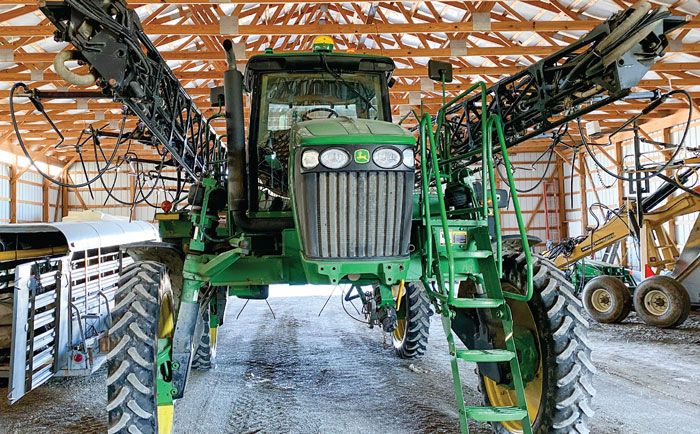A routine maintenance check-up on your sprayer will help ensure efficient and effective applications this spring and reduce stress when windows tighten due to weather conditions.
First things first, make sure to wear personal protective equipment (PPE) like rubber gloves, safety goggles and long sleeves when working with pesticide application equipment, says Ryan Bergman, Iowa State University extension agricultural spray application equipment expert.
“Consult specific chemical labels for proper PPE,” he says. “It’s important to make sure your sprayer is mechanically sound. Consult your owner’s manual for checklists and specifications to evaluate during this process.”
Nozzle Selection & Setup
Nozzle setup should be atop the checklist. Inspect your nozzles to see if they work well with the products you’re applying at the speeds and pressure you plan to operate, Bergman says.
“Some chemicals like dicamba and 2,4-D products have strict nozzle requirements, whereas other products like glyphosate allow more choices,” he says. “For example, there are only 4 types of TeeJet nozzles approved for use with Enlist Duo herbicide.”
“While one nozzle may be best for a given situation, it may be the worst choice for another…”
When applying multiple products, Bergman recommends referring to the label with the strictest nozzle requirements to select your nozzle for that application.
“If you want to operate at a wide range of speeds and pressures during the season, you may want to evaluate the benefits of a PWM (pulse-width modulated) spray system to provide a broader range of nozzle flow rates while managing droplet size more consistently.”
Ohio State University pesticide application expert Erdal Ozkan lists the following factors to consider when selecting nozzles:
- Sprayer operation parameters (application rate, spray pressure and travel speed)
- Type of chemical sprayed (herbicides, insecticides, fungicides)
- Mode of action of chemicals (systemic, contact)
- Application type (broadcast, band, directed, air assisted)
- Target crops
- Spray drift risk
“Before buying the nozzles and putting them on the boom, check the nozzle manufacturers’ catalogs or websites for charts showing which nozzle type will be best for a specific job,” Ozkan says. “Each nozzle type is designed for a specific type of target and application. While one nozzle may be best for a given situation, it may be the worst choice for another.”
Ozkan recently conducted a field experiment to determine which nozzles to choose in two different application situations: soybean diseases and wheat diseases. The experiment found that while a twin-fan pattern nozzle was best for controlling wheat head scab, it turned out to be the worst choice for protecting soybeans against diseases like rust and white mold, and insects like aphids, proving his point that one nozzle might be right for one situation but wrong for another. Ozkan recommends keeping several different nozzle types on the boom to switch from one to another instantly.

MAKE A LIST, CHECK IT TWICE. Save valuable time in the field by making sure your sprayer is ready to go this spring. Experts remind growers to keep an eye on the little things like proper tire inflation and joint lubrication.
“Nozzles are typically the least costly items on a sprayer, but they play a key role in the final outcome from a spraying job,” he says. “Pesticides work well if the rates on labels are achieved during application. This can be achieved only if the right nozzle types are on the sprayer.”
Before planting season starts, check the flow of each nozzle by running the sprayer with water. Using a SpotOn Sprayer Calibrator will simplify the process, Bergman says.
“While running the sprayer with water can be a time-consuming exercise, it helps you identify worn, plugged or damaged nozzles,” he says. “Nozzles with debris buildup can cause significant deviations in flow between nozzles on a common rail boom setup. The debris will cause the affected nozzle to experience a different pressure than non-plugged nozzles on another area of the boom and create rate variation across the boom.”
Nozzle alignment should also be examined during this process, Bergman says, as nozzle holders or mounts can move if booms frequently hit the ground or other obstructions.
Hit the Ground Plumbing
It’s important to regularly inspect the sprayer’s plumbing system to avoid chemical build up and potential cross contamination, Bergman says.
“Make sure all the lines are properly secured so there’s no risk of them getting caught as we go through the field,” he says. “Also, every now and then we should inspect the lines to make sure we’re not getting residue buildup in them. A common place where this occurs is at the end caps where the nozzle section ends. Remove and check the end caps for buildup, and clean if needed.”
Bergman adds that frequently cleaning the main solution strainer will reduce pressure drop in the system, improve the consistency of the spray application rate and also improve the life of spray system pumps.
Tips for Winterizing Your Sprayer
It never hurts to plan ahead — keep this checklist for the fall. Kansas State extension agronomy department educator Sarah Lancaster lists some of the key steps to take before putting the sprayer back in storage for the winter.
- Clean the sprayer to remove herbicide residues.
- Check and service the pump.
- Remove filters, nozzles, check valves and screens, and wash them by hand. You can store metal filters and screens in vegetable oil to prevent rusting.
- Remove pressure gauges and store them at room temperature.
- Remove as much water as possible. Consider using an air hose to blow out moisture.
- Add RV antifreeze with a corrosion preventer. Solutions designed to winterize sprayers are also available. Liquid fertilizer is another option but can cause corrosion.
- Circulate the antifreeze through the entire system, including the boom (if applicable). For boom sprayers, turn on one section at a time until you see the antifreeze come out of the nozzle openings, then cap the opening.
- Refer to your owner’s manual for other components, such as flow meters, rate controllers and electronics.
“Clean strainers will help ensure that you’re getting adequate product flow throughout the entire boom width to achieve the proper rate out of each nozzle on the machine,” he says. “Take the strainers out to inspect them and make sure they’re free of debris.”
Last But Not Least
It’s also important to clean the flow meters, Bergman says, and contact your local equipment dealership to help with recalibration if needed.
“Routine cleaning of the sprayer flow meter will ensure accurate application rates and reduce the calibration requirements for the solution system,” Bergman says.
He reminds growers to make sure fluids are at the proper level, filters are clean and all greaseable parts and joints are properly lubricated.
“Many boom suspension components require frequent lubrication to ensure adequate movement and can have an impact on boom height control performance,” Bergman says.
Don’t forget to properly inflate your tires, he says, as they need to be in good operating condition to handle high speeds and axle loads.







